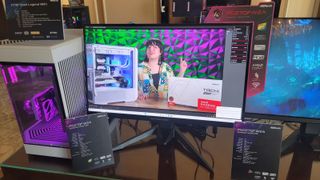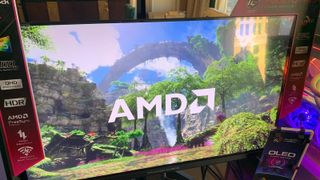ASRock unveils trio of Wi-Fi-enabled 27-inch Phantom Gaming monitors — IPS and OLED panels maxing out at 520 Hz
ASRock has the 27-inch size class well covered.

Last week, we got early word of new ASRock Phantom Gaming monitors that would be displayed at CES, and the news was scintillating. The headliner was undoubtedly the Phantom Gaming PG27FFX2A, which boasted a 520Hz refresh rate. We’ve finally had a chance to see the 27-inch PG27FFX2A in person, along with a few additional entries in the family, including some OLED goodness.
The PG27FFX2A is likely the most technically impressive for competitive gamers, boasting a fast IPS panel with a Full HD (1920 x 1080) resolution. ASRock promises a maximum refresh rate of 520Hz with AMD FreeSync Premium support. However, it wasn’t specified whether this is the native spec or if you’ll have to enable an overclock function in the OSD. Regardless, we’re looking at a 1ms response time, 1,000:1 contrast ratio (average for an IPS panel), maximum brightness of 400 nits, and 99 percent coverage of sRGB (90 percent DCI-P3).
You’ll likely need a Radeon RX 7000 Series graphics card for a data pipe sufficient to handle a 1080p stream at 520Hz. AMD’s latest Radeon graphics cards have the necessary HDMI 2.1 compliance to handle those data rates. The PG27FFX2A includes two HDMI 2.1 ports and one DisplayPort 1.4 port. You’ll also find two USB 3.0 Type-A ports, one USB 2.0 Type-A port, and a 3.5mm headphone jack. One curious addition is an integrated Wi-Fi antenna, which we imagine could be used for native media streaming services and cloud gaming.

If you’re adamant about the 27-inch screen size but want a little more resolution, there’s the Phantom Gaming PG27QFW2A. This IPS monitor bumps the resolution to QHD (2560 x 1440) but drops the maximum refresh rate to a still impressive 400Hz with FreeSync Premium support. You’ll find the same 1,000:1 contrast ratio, but maximum brightness takes a slight step backward to 350 nits. Available ports are more comprehensive with the PG27QFW2A, as you’ll get two each of HDMI 2.1 and DisplayPort 1.4, while a USB 3.0 hub offers up Type-C and Type-A ports for your peripherals. And like the PG27FFX2A, integrated Wi-Fi is included in the mix.
Rounding out the 27-inch trifecta is the Phantom Gaming PG0270W2A, which also has a QHD resolution. The big news with the PG0270W2A is that it swaps out the IPS panel in favor of OLED technology. Opting for an OLED panel means the native refresh rate is 360Hz (FreeSync Premium Pro supported), which is still impressive (if you leave out the overachieving 480Hz ROG Swift OLED PG32UCDP).
As is typical with OLED panels, response time is impressive at just 0.03ms, and maximum brightness is not a strong suit, with a maximum of 250 nits. However, the 1,500,000:1 contrast ratio is no doubt a critical advantage of this panel type. Wi-Fi also appears on the PG0270W2A along with two HDMI 2.1 ports, one DisplayPort 1.4 connection and a single USB-C 3.0 port.
ASRock has not yet announced pricing or availability for its new 27-inch Phantom Gaming monitors family.
Stay On the Cutting Edge: Get the Tom's Hardware Newsletter
Get Tom's Hardware's best news and in-depth reviews, straight to your inbox.
Brandon Hill is a senior editor at Tom's Hardware. He has written about PC and Mac tech since the late 1990s with bylines at AnandTech, DailyTech, and Hot Hardware. When he is not consuming copious amounts of tech news, he can be found enjoying the NC mountains or the beach with his wife and two sons.
- Paul AlcornManaging Editor: News and Emerging Tech
-
vanadiel007 Why use DP 1.4 on this new product? AMD 7000 cards support DP 2.1, and therefore can handle the high refresh rates over DP.Reply
Not everyone wants to use a HDMI connection. -
Sleepy_Hollowed Reply
More than likely to save money and to release it now rather than later.vanadiel007 said:Why use DP 1.4 on this new product? AMD 7000 cards support DP 2.1, and therefore can handle the high refresh rates over DP.
Not everyone wants to use a HDMI connection. -
2Be_or_Not2Be Including WiFi on these monitors is ridiculous. If you think you could use it for streaming, then you're at the mercy of yet another low-power CPU solution & its interface for your streaming platforms. Plus, who watches on a standalone, small 27" monitor when you could watch it on a large-screen 4K TV? Maybe it would work for someone who doesn't have a TV & wants only one display.Reply
Sidenote: If your PC is running on WiFi, then both your monitor & your PC could be sharing your wireless bandwidth. Just save the cost of the chip & skip adding these unnecessary add-ons! -
vanadiel007 Reply2Be_or_Not2Be said:Including WiFi on these monitors is ridiculous. If you think you could use it for streaming, then you're at the mercy of yet another low-power CPU solution & its interface for your streaming platforms. Plus, who watches on a standalone, small 27" monitor when you could watch it on a large-screen 4K TV? Maybe it would work for someone who doesn't have a TV & wants only one display.
Sidenote: If your PC is running on WiFi, then both your monitor & your PC could be sharing your wireless bandwidth. Just save the cost of the chip & skip adding these unnecessary add-ons!
I thought for a moment the WiFi was for streaming the display, so you could have a wireless display rather than a wired display.
Hopefully it is for that, but on second thought likely not.... -
Gu3sts Reply
Shame if it's not for wireless monitor, we already have wireless keyboards & mice. Just missing a WiFi antenna(s) on gpu to have a true wireless connection. Wait if that's a 540Hz display does that mean 540 fps just to get the image?vanadiel007 said:I thought for a moment the WiFi was for streaming the display, so you could have a wireless display rather than a wired display.
Hopefully it is for that, but on second thought likely not....
Most Popular





